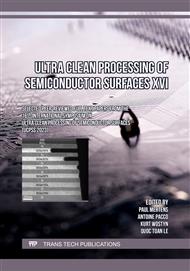[1]
Y. Yamada, Charge-induced attraction of particles in surface preparation and clean processes, Surface Preparation and Cleaning Conference (2010).
Google Scholar
[2]
S. Pani, Generation and elimination of silicon pitting for 300mm CMOS process technologies, Journal of Vacuum science & technology B, 35, 061206 (2017).
Google Scholar
[3]
X. Yang, Lithography develop process electrostatic discharge effect mechanism study, SPIE Advanced Lithography, Vol 9424 (2015).
Google Scholar
[4]
D. Mui, Wafer surface charging model for single wafer wet-spin process, IEEE Trans., Vol. 24 (2011).
DOI: 10.1109/tsm.2011.2162346
Google Scholar
[5]
R. Neto, Electric Field Assisted Hydrogen Fluoride Etching of Silica, Mathematical, Physical and Engineering Sciences Proc., Vol. 465, pp.3447-3462 (2009).
DOI: 10.1098/rspa.2009.0216
Google Scholar
[6]
R. Santiago, Electric field assisted hydrogen fluoride etching of silica, Proc. R. Soc. 465, p.3447 – 3462 (2009).
DOI: 10.1098/rspa.2009.0216
Google Scholar
[7]
J. Park, Electrochemical Induced Pitting Defects at Gate Oxide Patterning, IEEE Transactions on semiconductor manufacturing, 26(3), 315-318 (2013).
DOI: 10.1109/tsm.2013.2259271
Google Scholar
[8]
Y. Ezaki, GOI improvement in analog CMOS split gate process, 5th conference on ASIC (2003).
DOI: 10.1109/issm.2003.1243257
Google Scholar
[9]
M. Rauscher, Porous silicon formation and electropolishing, Physical review E, Vol. 64, 031604 (2001).
Google Scholar
[10]
K. Sano, Minimizing wafer surface charging for single-wafer wet cleaning for 10 nm and beyond, Solid state phenomena, Vol. 255, pp.277-282.
DOI: 10.4028/www.scientific.net/ssp.255.277
Google Scholar
[11]
K. Sano, Effect of VUV lamp on wafer charging by single-wafer wet clean, ECS Trans., Vol. 80 (2017).
DOI: 10.1149/08002.0081ecst
Google Scholar
[12]
JP Carrere, New mechanism of plasma induced damage on CMOS image sensor: analysis and process optimization, Solid state electronics, Vols 65-66, pp.51-56 (2011).
DOI: 10.1016/j.sse.2011.06.037
Google Scholar
[13]
F. Boeuf, Silicon photonics platform from datacom to sensing applications, IEEE BiCMOS and compound semiconductor integrated circuits and technology symposium (2021).
DOI: 10.1109/bcicts50416.2021.9682461
Google Scholar


